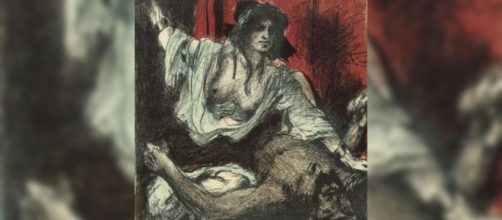Art can take on unintended and contradictory meaning. Illustrating that double-speak is Lovis Corinth’s lithograph “Judith Beheads Holofernes,” at the Minneapolis Institute of Art new show of biblical heroine.
The “Book of Judith” describes a chaste widow who saved the ancient town of Bethuliah from an Assyrian army attack by beheading the general who led the charge.
False impression
But the way Corinth chose to tell the story put an incongruous spin on it. Judith’s heroic act to save her people gets lost in an image of a manic-looking woman in disheveled clothing that exposes her breasts.
The horrific confrontation, then, takes on the appearance of a sexual battle with the female as the weapon. Picasso’s “Woman with Stiletto” – all breasts and fangs – comes to mind. The only thing missing in Corinth’s vision are the fangs.
Corinth’s perverse take of Judith calls up Germaine Greer famous line from her book “The Female Eunuch”: “Women have very little idea how much men hate them.”
How else to explain why Corinth would make Judith out to look as if she were in some sexual frenzy while trying to save her city from a hostile takeover. It couldn’t have been easy for her to slay the general the way she did.
You can see her revulsion in Caravaggio’s painting on exhibit with Corinth’s version at the Minneapolis Museum.
Clearly, Greer didn’t take artists like him into account. Instead of twisting Judith’s heroism into hedonism, he focused on her challenge.
The real story
Caravaggio shows the moment Judith’s sword separates the general’s head from his body. You see his agony, but you also see her distraught expression as she wields the sword, her reticence as she rears back from her action.
But hedonism is all there is in Corinth’s version. Unaccountably, the Museum of Modern Art in New York, where a copy of his lithograph is held, notes on its website that his rendition is a “romanticized” version of the Biblical tale. Romanticized?
MoMA takes even more liberties with the Biblical story than Corinth by calling his lithograph “an allegory of the dangers of female empowerment.”
With a sexist remark like that put into print, it seems a historical inevitability that British historian Katy Hessel would pen a book titled “The Story of Art Without Me.”
Hessel includes many firsts that can stun even the most knowing art lover.
For instance, did you know that the first solo show by a female artist didn’t occur until 2016 with the art of Clara Peeters at the Prado?
As upending as this revelation is, the biggest shock is that it was necessary for Hessel to write this book in the 21st century. Sexism seems such a tired subject at this point.
'The Female Eunuch' again
Yet, the bias lives on. Hessel quotes George Baselitz saving in 2013 “Women don’t paint very well.” Isn’t that what John Ruskin said a century earlier?
As worthwhile as this book is, the question nags: Do we have to go to the extreme of writing art history that keeps men out in order for women to get some equity?


